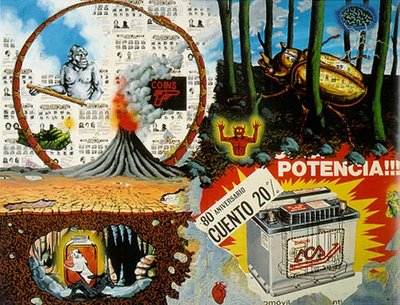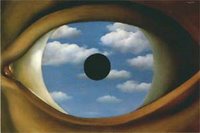Here is the script for an oral presentation on Kant, a notorious Enlightment thinker, that I delivered to the Philosophy of Art class this spring. It was a bit ambitious. In each section beginning with bold type, the perspective shifts from one writer to another. I begin with an etching by Francisco de Goya, and then hammer into blockquotations from Kant's
3rd Critique, William Blake's
Jerusalem, Max Weber's
Sociology of Religion, and then slowly segue into the writings of Georges Bataille. (The sections marked "The Aztecs" are all direct quotations from
The Accursed Share) --I read at an extremely fast pace:
 El Sueno de la Razon.
El Sueno de la Razon. Fallen asleep at his writing table, quill in hand, working deep into the night. Too deep. Imagination produces a monstrous cacophony of nightmarish brood: owl-bears, bat-dragons, scape-goats, kobolds, and chimeras. It is a monstrous void, entirely hidden from the daytime world, obscured very the very light of reason.
The Sleep of Reason?
Kant.A poet ventures to give sensible expression to rational ideas of invisible beings, the realm of the blessed, the realm of hell, eternity, creation, and so on. p. 183
Blake.Beauty is exuberance.
The Sublime is monstrous. In it we find a will of nature that runs counter to our interests. Its suggestive power commands the imagination, presenting the mind with a thing that is absolutely large: the mountain, the ocean, the cosmos. But what thing could be Sublime? What thing?
Weber.For this reason, the primary target of Zoroaster’s indignant ethical rationalism was orgiastic ecstasy, particularly the intoxicating cult of the soma sacrifice, which he deemed unworthy of man and cruel to beasts. For the same reason, Moses directed his rationalized ethical attack against the orgy of the dance, just as many founders or prophets of ethical religion attacked 'whoredom'
('whoredom' - that is, the female priesthood.)
Ethical eschatology. The Sleep of Reason?
Kant.For going to the extreme of explaining everything only mechanically must make reason fantasize and wander among chimeras of nature of natural powers that are quite inconceivable, just as much as a merely teleological kind of explanation that takes no account whatever of the mechanism of nature made reason rave. p. 297.
The Sleep of Reason?
Kant. is obsessed with purpose. In purposiveness, he can isolate the causes and the intentions of nature, a universal telos. Kant’s quest for telos, that a thing carries its end within itself– seeks an ultimate purpose for all things. The success of his project, this teleological will to power, depends on one final act of murder. Reason must conquer nature. Kant must propose the contra-purposiveness of nature. Otherwise, his entire system falls into crisis.
Kant must slay the dragon. Heroic Matricide.
Blake.I see the four-fold Man, the Humanity in deadly sleep…
In heavy wreaths folds over every nation: cruel works
Of many Wheels I view, wheel without wheel, with cogs tyrannic
Moving by compulsion each other, not as those in Eden, which,
Wheel within wheel, in freedom revolve in harmony and peace.
Static eschatology.
Kant.Nature on the other hand, is very far from having adopted [humanity] as its special darling … but has in fact spared him no more than any other animal from its destructive workings: plague, famine, flood, frost, or attacks from other animals large or small, and so on. p. 318.
Kant has expelled the beauty from nature, and from his Critique, replacing it instead with the violence of conquest and despotism.
Parthenogenesis. Asexual Reproduction.
Man is indeed the only being on earth that has understanding and hence an ability to set himself purposes of his own choice, and in this respect he holds the title of lord of nature. p. 318.
The ultimate purpose of nature, its telos, is the lordship en - titled exclusively to human beings for setting our own purpose, and for using nature as a means to our ends. Human beings are superior to other animals, because they are useful to us.
The Aztecs.Around Easter time, they undertook the sacrificial slaying of a young man of irreproachable beauty. He was chosen from among the captives the previous year, and from that moment he lived like a great lord ... He went through the whole town very well dressed, with flowers in his hand … they all knew he was the image of Texcatlipoca, one of the greatest gods, and prostrated themselves before him, worshipping him wherever they met him.
Kant.Hence only culture can be the ultimate purpose that we have cause to attribute to nature with respect to the human species. p.319
Kant submits that culture has two necessary aspects: the culture of skill and the culture of discipline.
The Aztecs.Twenty Days previous to the festival they gave this youth four maidens, well prepared and educated for this purpose. During thos twenty days he had carnal intercourse with the maidens. The four girls they gave him as wives and who had been reared with special care for that purpose were given names of four goddesses.
Kant. The culture of skill is purely economic. Human beings require skill to transform raw nature into raw materials, that is, into commodities with a purpose for economic use. The culture of discipline is the culture of science, education, and the arts. Art serves the purpose of making man more cultured.
Commodity fetishism.
The Aztecs.The women stepped aside and left him. As he got to the place where he was to be killed, he mounted the steps by himself and on each one of these he broke on of the flutes which he had played during the year.
Kant. Purposiveness is an idea that is elementally connected to utitlity, to economy, and to the commodification of the every thing, that is, the reduction of the world, both sacred and profane, into thingly-ness.
The Aztecs.These now grabbed him and threw him onto the stone block, and holding him by fett, hands and head, thrown on his back, the priest who had the stone knife buried it with a mighty thrust in the victim’s breast and, after drawing it out, thrust one hand into the opening and tore out the heart, which he at once offered to the sun.
Respect was shown for the young man’s body.
Sacred Regicide.
Bataille. In his
Theory of Religion, Bataille begins with nature. We ask - when one wolf kills another wolf, does the victor pause to celebrate? Bataille wonders:
If the animal that has brought down its rival does not apprehend the other’s death as does a man behaving triumphantly, this is because its rival had not broken a continuity … The continuity was not called into question, but rather the identity of desires of two beings set one against the other in mortal combat.
For Bataille, the animal world is a world of immanence, an embryonic experience of intimacy. “
Transcendence,” Bataille says, “
is nothing if it is not embryonic.” Unlike Kant, Bataille is not suggesting the superiority of human beings. It is a world that is closed to us, since the animal is in the world like “
water in water.” For Bataille, the world of culture has no specific claim to mastery over the animal world – they are only different.
Bataille, therefore, posits that the creation of tools signified the first major event of culture. The tool is subordinated to the one who uses it, the one who invested time into its creation, who determined its purpose from the very beginning:
Utility. This is one of the most remarkable and fateful aberrations of language. … The stick digs the ground in order to ensure the growth of a plant; the plant is cultivated in order to be eater; it is eatern in order to maintain the life of the one who cultivates it … The absurdity of an endless deferral. p. 28
History is irrevocably drawn towards manufacture and the simultaneous objectification of life into banality. Bataille reserves art alone, unlike other manufactured objects, from the fate of commodification. Bataille understands art as a true end, an end that exists separate from the chain of teleological tyranny. The purpose of art, and the religious sacrifices of the Aztecs, is to remove humanity from purposiveness, to annihilate the cyclical wheel within wheel of utility, establishing once again the sacred intimacy of water within water.
Bataille.The world of intimacy is as antithetical to the real world as immoderation is to moderation, madness to reason, drunkenness to lucidity. There is moderation only in the object … The world of the subject is the night: that changeable, infinitely suspect night which, in the sleep of reason produces monsters. (from The Accursed Share)
El Sueno de la Razon





















